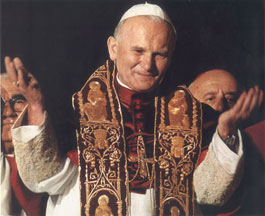 |
| Help from above... and below |
Although a papal citation of this sort rarely, if ever, states why a person is inducted into the "Golden Militia," there can be no doubt that Donovan earned his knighthood by virtue of the services he rendered to the Catholic hierarchy in World War II, during which he served as chief of the Office of Strategic Services (OSS), the wartime predecessor to the Central Intelligence Agency (CIA). In 1941, the year before the OSS was officially constituted, Donovan forged a close alliance with Father Felix Morlion, founder of a European Catholic intelligence service known as Pro Deo. When the Germans overran western Europe, Donovan helped Morlion move his base of operations from Lisbon to New York. From then on, Pro Deo was financed by Donovan, who believed that such an expenditure would result in valuable insight into the secret affairs of the Vatican, then a neutral enclave in the midst of fascist Rome. When the Allies liberated Rome in 1944, Morlion reestablished his spy network in the Vatican; from there he helped the OSS obtain confidential reports provided by apostolic delegates in the Far East, which included information about strategic bombing targets in Japan.
Pope Pius' decoration of Wild Bill Donovan marked the beginning of a longstanding, intimate relationship between the Vatican and U.S. intelligence that continues to the present day. For centuries the Vatican has been a prime target of foreign espionage. One of the world's greatest repositories of raw intelligence, it is a spy's gold mine. Ecclesiastical, political and economic information filters in every day from thousands of priests, bishops and papal nuncios, who report regularly from every corner of the globe to the Office of the Papal Secretariat. So rich was this source of data that shortly after the war, the CIA created a special unit in its counterintelligence section to tap it and monitor developments within the Holy See.
But the CIA's interest in the Catholic church is not limited to intelligence gathering. The Vatican, with its immense wealth and political influence, has in recent years become a key force in global politics, particularly with Catholicism playing such a pivotal role in Eastern Europe and Latin America. Unbeknownst to most Catholics, the Vatican, which carefully maintains an apolitical image, not only has a foreign office and a diplomatic corps, but also has a foreign policy. And with Polish Communists embracing Catholicism and Latin American Catholics embracing communism, the U.S. government and particularly the CIA have recently taken a much greater interest in Vatican foreign policy. A year-long Mother Jones investigation has revealed a number of unlikely channels — both overt and covert — which the agency uses to bring its influence to bear upon that policy. (more...)
Spooky Catholic
What if the homomafia, masonic mafia, and St. Galen Mafia are all one and the same? Why have we not seen fissures develop between them over the last 70 years? Why do they seem to act with one mind? Consider that the CIA serves what is essentially a masonic empire. It controls much of the Latin American hierarchy. Why not the curia and papacy?

No comments:
Post a Comment